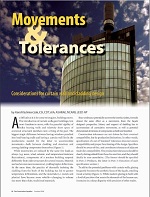Thermal Simulations – Applicability
We are sometimes asked to simulate or test assemblies, in order to verify whether the inferior specifications are met. It’s always awkward for us to volunteer to identify the engineering question actually worth answering, or to actually respond to the question no-one have asked. For the benefit of those specification writers who are still on speaking terms with us, below is a simple overview of thermal simulations’ applicability:
Generally speaking:
- 1D simulations are suitable for uniformly-layered make-ups of partitions (i.e. adhered “sandwich” roofing assembly),
- 2D simulations are suitable for one-directional variations of assemblies (i.e. studwork),
- steady-state simulations are suitable for low heat storage assemblies (i.e. fenestration),
- transient simulations are necessary for high heat storage assemblies, (i.e. masonry)
- moisture transport analysis are necessary for permeable and water storage assemblies (i.e. solar transport in brick-veneered wall),
- CFD analysis are necessary for convection-sensitive assemblies (i.e. double skin walls),
- radiation analysis are necessary for radiation-sensitive assemblies.
Also:
Sunshades: More often than not, the exterior architectural trim often casts negligible shadows, and therefore doesn’t deserve to be called sunshades. You need Solar Heat Gain and Shading Studies, in order to verify how much energy can be saved by the exterior shading of a certain shape and configuration, and Daylight and Illumination Studies in order to find out how much less glare your occupants would suffer. This should happen before the design leaves your office.
3D FEA Simulations: The typical sunshade bracket penetration is a good example where you may need them. Use 3D FEA simulations sparingly, because they are approximately 10 times more expensive than 2D FEA simulations. Not that we mind, but the owner may…
CFD. In your typical sunshade scenario, the sunshades act as a conductive heat sink, dispersing the energy to the atmosphere. They are sensitive to the velocity of air, which washes the heat away from them. To find out the wind-chill factor, you may need CFD analysis of them. On the other side, the interior spaces may experience a stagnant air, causing condensation and moisture damage to interior materials. To find out how much heat is delivered to them by convection, you may again need CFD analysis.
Water Vapor Permeability: If you have any doubts about your team’s ability to design vapor retarders in assemblies composed of permeable or semi-permeable layers, you are well advised to require moisture transport analysis, such as WUFI. You guessed it: these materials are seldom incorporated in the typical architectural glazing, so don’t place it in the Division 8. Moreover, the design of these assemblies is seldom delegated, and therefore they should be verified by simulations before issuing the CDs. If they contain a varying component (i.e. exterior or interior cladding) which is performance-specified, the whole assembly may need to be re-checked by the contractor.
High Heat Storage Capacity. Those assemblies which can ride through a cold winter night or a hot summer day may require transient simulations. You guessed it: these materials are seldom incorporated in the typical architectural glazing, so don’t place it in the Division 8.
U- Value. You may prefer to identify the U-value in 2D FEA simulations, and only apply spoilage factors caused by irregular details, derived from the more expensive 3D simulations. The 3D FEA simulations should be primarily used for the condensation risk assessment, or identification of global coefficients otherwise challenging to obtain. Why? Because they are expensive.
Architectural Glazing. Would it be too dark inside if you allowed glass VLT 15? Would prison guards be blinded by glare from windows precisely when inmates are out? Surprisingly often, the answer is: we don’t know, because nobody checked it. This is why you may need Spectrophotometric Simulations.
Solar Heat. Would occupants complain about getting tan at their desks? Is SHGC 35 too much? Again, surprisingly often, the answer is: we don’t know, because nobody checked it. We get called after the multimillion dollar glazing has already been installed to confirm the worst suspicions. You need Solar Heat Gain and Shading Studies before the CDs are issued.
[youtube]yKhWmfXpoA4[/youtube]

 Condensation Risk Assessment
Condensation Risk Assessment Facade Access
Facade Access Facade Engineering. How To Design a Functional Building Enclosure
Facade Engineering. How To Design a Functional Building Enclosure Facade Impact Resistance Manual
Facade Impact Resistance Manual Foggy Glass Disease
Foggy Glass Disease How To Write and Read a Forensic Report
How To Write and Read a Forensic Report Movements and Tolerances
Movements and Tolerances Review of Curtain Walls, Focusing on Design Problems and Solutions
Review of Curtain Walls, Focusing on Design Problems and Solutions Transitions: How to Design Facade Interfaces
Transitions: How to Design Facade Interfaces When You Need A Window – Solar Design
When You Need A Window – Solar Design
Leave a Reply
You must be logged in to post a comment.